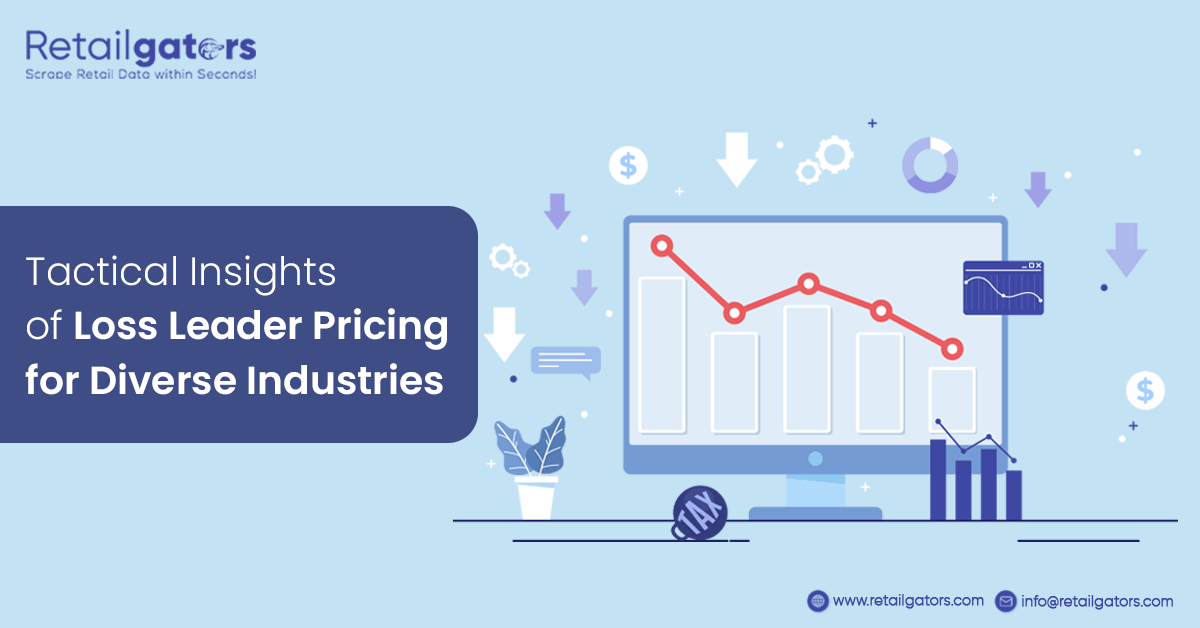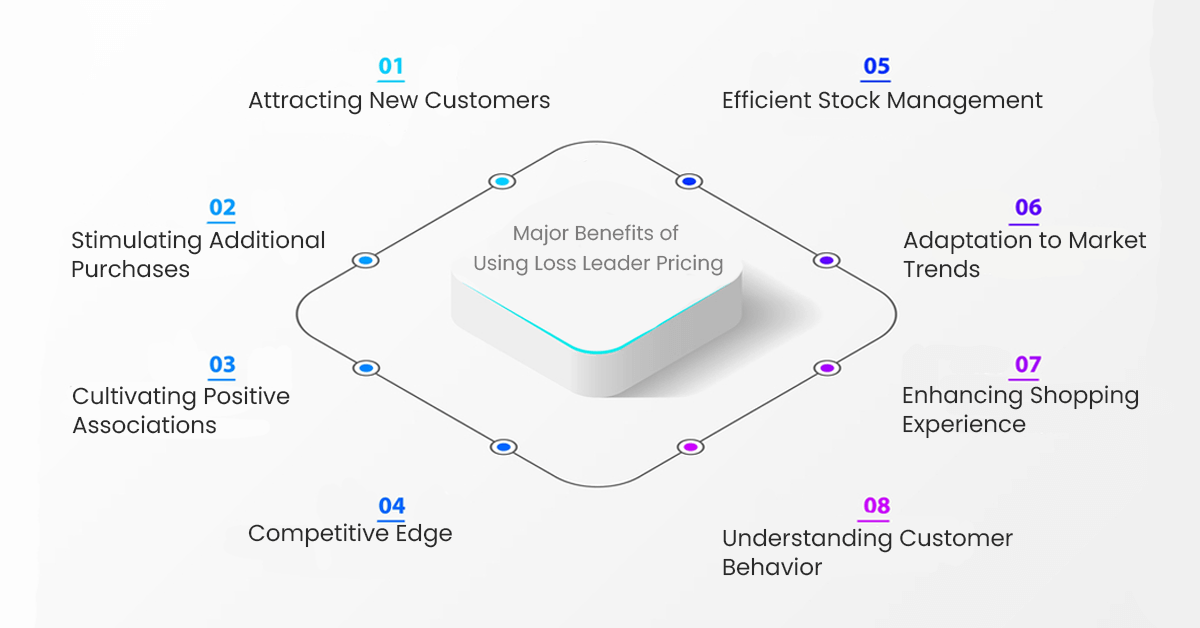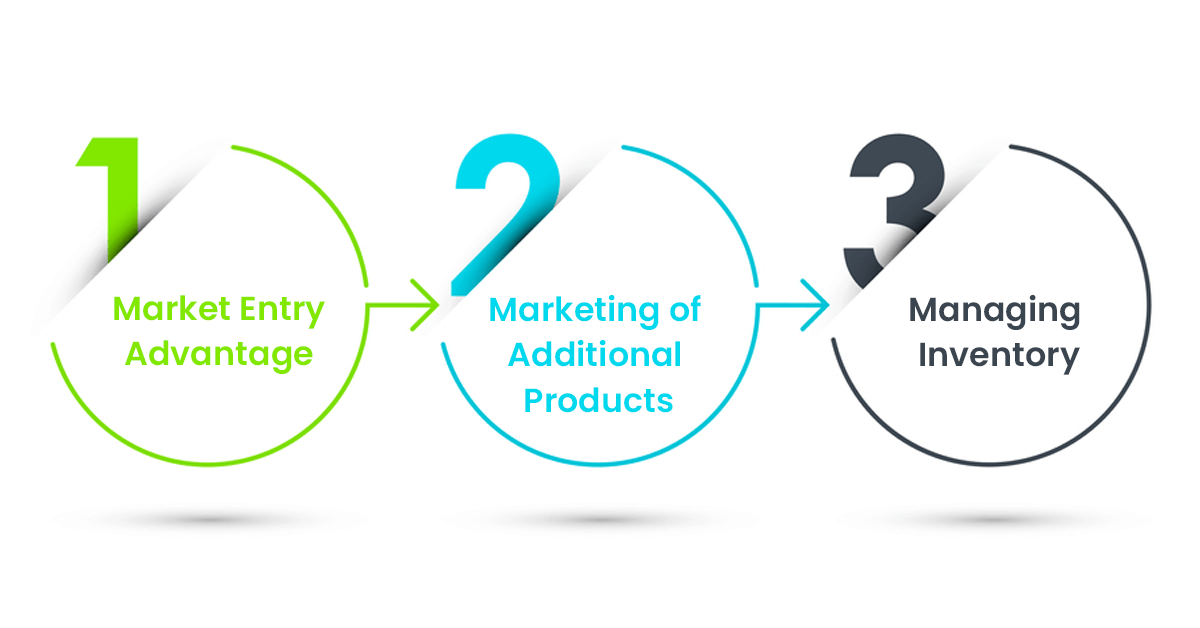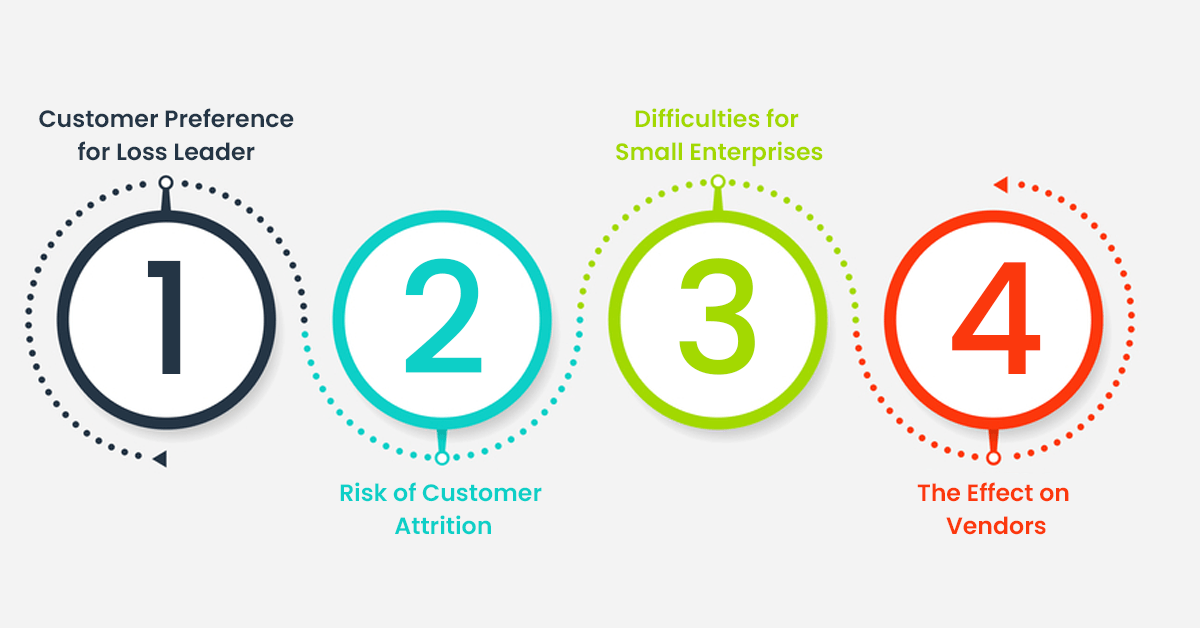
Using a range of pricing methods is necessary while navigating a competitive market. The tactics are meant to draw in and keep consumers while preserving earnings. Some organizations use loss leader pricing strategy to boost sales and connect with their target audience. This approach involves selling a product lower than its production cost, intending to entice customers and drive additional sales.
What is Loss Leader Pricing?
Loss Leader Pricing is a strategy used for pricing the products lower than the cost of production to attract new customers or sell additional products to the customers.
Companies generally use loss leader pricing while entering new markets or increasing their market share.
Imagine going to a store and finding your favorite gadget or essential item priced way lower than usual. That's the magic of loss leader pricing. It's when a store deliberately sells a product for less than it costs them, with a clever plan in mind. The name "loss leader" makes sense when you know the store is okay with losing a bit of money on that first item. These customers, in turn, are likely to buy other things that make up for the initial loss.
With the help of loss leader products, retailers believe that the customers are likely to buy other products, which are being provided at total retail price. The profit from additional purchases compensates for the loss quite well.
What is the Purpose of Loss Leader Pricing?
Loss leader pricing is strategically employed to draw in new customers. By lowering the price of a product below the typical market average, brands seek to allure buyers and prompt them to visit online or brick-and-mortar stores. This tactic often results in customers making additional purchases, even of items they may not have initially intended to buy. As they navigate the store, exploring various corridors and shelves, the likelihood of purchasing other products increases.
Furthermore, a loss leader pricing strategy extends beyond the immediate benefit of attracting customers. By offering discounted products alongside regular-priced items, brands create a dynamic shopping experience. Enticed by the initial bargain, customers often discover and explore a broader range of the brand's offerings.
This approach shows customers the variety of products available and makes them more loyal to the brand. When people see value in discounted and regular-priced items, they are likely to return for more purchases. Moreover, eliminating excess inventory through loss leader pricing helps keep a smooth and efficient supply chain.
It lets businesses handle their stock levels well, avoiding a buildup of extra products.
This, in turn, makes the business more flexible and responsive, allowing brands to quickly adapt to changes in market trends and what consumers prefer.
Major Benefits of Using Loss Leader Pricing

When you see those amazing discounts, it's not just about the low prices. Businesses are trying to make your shopping experience awesome and keep things running smoothly.
Attracting New Customers
Imagine a store offering something you love at a lower price than usual. That's what businesses do with loss leader pricing—they make things super affordable to attract new customers. It's like saying, "Come check us out!" and gives the chance to grow their group of customers.
Stimulating Additional Purchases
The store knows you'll likely buy more stuff while you're there. They expect you to grab some extra goodies even if they lose a bit on the first thing. This helps them sell more overall and make up for the initial loss.
Cultivating Positive Associations
When you find incredible deals on some things and also like the regular-priced stuff, you start feeling attached to the store. It's like having a favorite place to shop. This good feeling makes you want to return for more, building loyalty to the brand.
Competitive Edge
Sometimes, businesses use loss leader pricing to stand out, especially when entering new areas or getting more people interested. It's like waving a flag to say, "Hey, look at us! We've got something special!" This makes them more noticeable and gives them an edge over other businesses.
Efficient Stock Management
Loss leader pricing helps them avoid that. By selling some things at a discount, they ensure everything gets sold and avoid wasting extra stuff. It's like keeping things tidy and efficient.
Adaptation to Market Trends
The world changes, and people's preferences change too. Loss leader pricing helps businesses stay flexible. They can quickly adapt to what people want and keep up with the latest trends, making sure they offer the right stuff at the right time.
Enhancing Shopping Experience:
That's what businesses want. They want you to enjoy the experience. So, loss leader pricing isn't just about low prices; it's about making your shopping trip exciting and enjoyable.
Understanding Customer Behavior:
Lastly, when many people visit the store for great deals, businesses learn more about what customers like and want. It's like getting to know your friends better. This information helps businesses make smarter decisions about what to offer in the future.
Major Advantages of Loss Leader Pricing

Loss leader pricing is a marketing approach in which a product is sold at a price lower than its market cost in order to attract buyers. The following are some major advantages of implementing this strategy:
- Market Entry Advantage
New Market Penetration
It's challenging to persuade buyers to test your items when you're just starting in a market with many established competitors. Giving consumers a deal at loss leader rates might encourage them to try your brand.
Diminished Customer Risk
Offering goods at a discount or less than retail lessens the chance that buyers may attempt a new brand. It encourages people to investigate your offers more, which might result in long-term partnerships.
Impressing Customers
Even if you are selling at a loss at first, you can win over customers with your quality and service after they enter your store due to alluring offers. This could make up for your early losses with recurring business.
- Marketing of Additional Products
Preventing Obsolescence
Older items may become outdated in marketplaces that move quickly and where trends shift often. This is avoided by using loss leader pricing, which promotes sales of older products before the arrival of fresh ones on occasions such as Black Friday or seasonal holidays. A Rise in Traffic Loss leader promotions draws consumers who could find and investigate other products in your business, boosting sales overall.
Impact of Word-of-mouth
Happy consumers frequently talk about their excellent experiences. Outstanding offers may encourage them to tell others about you, increasing your clientele.
Strategic Pairing
You can increase sales of higher-margin products by strategically using loss leaders to promote related or complimentary items. For example, providing loss leads through scarves and socks encourages coat sales in a clothing company.
- Managing Inventory
Clearing Extra Stock
Having less inventory can be problematic for businesses. Loss leader price keeps inventories from stagnating by encouraging sales of these excess products, particularly in highly competitive marketplaces like the apparel industry.
Major Disadvantages of Loss Leader Pricing

Loss leader pricing involves carefully recruiting consumers, minimizing expenses, and assuring profitability. Businesses must examine the downsides and devise measures to reduce the impact.
Customer Preference for Loss Leader
Targeted Product Attraction: You might want to draw attention to other items, but customers will only pay attention to the loss leader that is being marketed. If not correctly handled, this limited concentration might result in losses and negatively affect total sales diversification.
Risk of Customer Attrition
Temporary Customer Base: Once regular rates resume, customers drawn in by the lower price may decide not to stick around. Certain customers could only be able to afford things during sales, and once regular prices are restored, they might go back to their prior suppliers.
Difficulties for Small Enterprises:
Recovering Expenses: Small businesses may find it challenging to sustain losses from the loss leader approach, which makes it difficult for them to compete with larger firms that have access to greater resources and a wider variety of products.
The Effect on Vendors:
Pressure on the Cost of Suppliers: Businesses may pressure suppliers to lower costs by using loss leader tactics across a range of items. Suppliers who depend significantly on a certain brand may be impacted by this, which might force them to work together to reduce total losses.
How Loss Leader Pricing Strategies Helps Businesses?
The loss leader pricing strategy is a purposeful pricing method in which a product is sold at a price lower than its cost in order to attract buyers. This strategy draws customers into a store or website by displaying a heavily discounted item, assuming they will also purchase other things. While the sale of the loss leader may result in a financial loss for the company, the idea is to capitalize on the increased foot traffic or web visits by driving sales of other goods with greater profit margins and compensating for the initial loss.
On the other hand, using a loss-leading technique necessitates a careful assessment of possible dangers. Customers may become conditioned to expect frequent discounts if this strategy is used indefinitely, potentially hurting average sales at conventional pricing. Furthermore, selling things below cost might result in quick financial losses if not managed properly. As a result, organizations must evaluate the strategy's influence on overall profitability and consumer behavior to ensure it is consistent with their long-term goals and financial viability.
Popular Examples of Loss Leader Prices
Our favourite and well-known businesses have enticed us to make impulsive purchases by using the loss leader price approach. For Netflix, it has worked wonderfully, but not as much for Subway. Let's explore loss leader pricing examples to understand the market scenarios.
Gillette
Gillette has engaged in loss leader pricing, which involves undercutting prices on its mechanical razors. After customers received their inexpensive razors, the blades on these devices quickly became dull and needed to be changed. The loss leader sales cycle was completed when they bought further Gillette items in addition to replacing blades.
Subway
The $5 footlong illustrates loss leader pricing that was too good to be true in the marketplace. After the notorious $5 footlong, the brand went from being another cheap sub restaurant to a reasonably priced lunch option.
The range of sandwiches available to consumers was what made Subway successful. But the selection was so vast that it ate into the revenue of more costly subs. An essential component of a loss leader pricing plan is that profitable goods must offset loss-making ones. In the case of Subway, that didn't occur. Even though fresh sub-businesses still exist today, sales have significantly decreased in the years after the end of the $5 footlong period.
Costco
Megastore Costco Families all throughout the country adore Costco because it selects goods in bulk and at affordable rates for everyday necessities. Families make the most of their time by allocating an hour or more for the excursion, as these stores are dispersed. Realizing this, Costco launched a loss leader with $1.50 hotdog combinations with a giant Coke. There isn't a faster food chain that can match that pricing. This loss leader functions as one might anticipate; it encourages families to spend more time shopping there if they know they can get a cheap snack. The perceived value of the products at Costco is a fundamental component of this loss leader. They had to save you a lot more money on that 48-count pack of Tic Tacs if they could sell you a hotdog combination for $1.50.
IKEA
IKEA, well-known for being a maze, has cleverly placed its stores to use loss leader pricing. Although the goods in this store range in price from less than $5 to far over $2,000, buyers are likely to make more purchases if arranged in the showroom adjacent to one another. For instance, an IKEA bedroom display may include a $200 bed frame, a $500 mattress, and a $25 light that looks very cool. You came in for a bed, but what catches your eye is the lamp, and it's not as expensive as the $700 mattress and frame. What's an extra $25 for the light if you were already going to get the mattress and bed frame?
Toyota
December is the ideal month to buy a car because it's the end of the year. That's because of loss leader pricing, you guessed it. Toyota wants to create a place for new inventory at the end of the year by getting rid of its old stock. It will certainly work if many people are drawn to the dealerships to purchase the outdated inventory at a great discount. However, Toyota is not the only automaker using loss leader pricing; premium companies like BMW, Subaru, and Honda all utilize this tactic to control their inventory.
Netflix
Although Netflix is well-known, you might not be aware that it attracts thousands of new users annually by using the loss leader tactic. To get users to stick with the monthly subscription, the firm is giving away a free month of films and series (shows that they still have to pay royalties to stream) in exchange for a 30-day trial. This type of introductory pricing allows clients to try the goods out before purchasing.
Conclusion
Loss leader pricing isn't just a way to attract customers; it is crucial in achieving broader business goals. It influences how consumers shop, encourages a variety of brands, fosters loyalty, and improves how efficiently the business operates. By carefully offering discounted and regular-priced products, brands create a situation where everyone wins—customers enjoy appealing deals, and businesses see more engaged customers while efficiently managing their inventory.
While loss leader pricing requires careful planning and execution, businesses that master this art are reaping the rewards of increased customer traffic, higher sales volumes, and enhanced brand loyalty. It's a strategic move that, when done right, positions a business for sustained success in a competitive marketplace. So, the next time you encounter an unbeatable deal, remember that it results from a well-crafted loss leader pricing strategy. Retailgators deliver end-to-end services from price scraping to data scraping that provide efficiency in decision-making for businesses.








Leave a Reply
Your email address will not be published. Required fields are marked